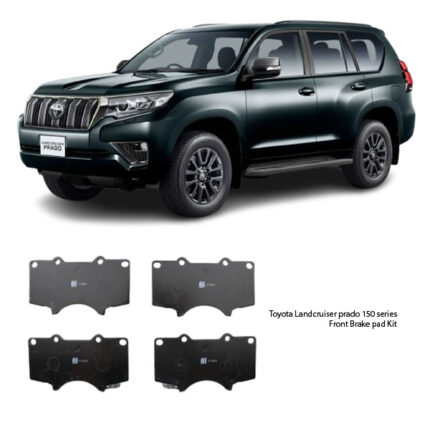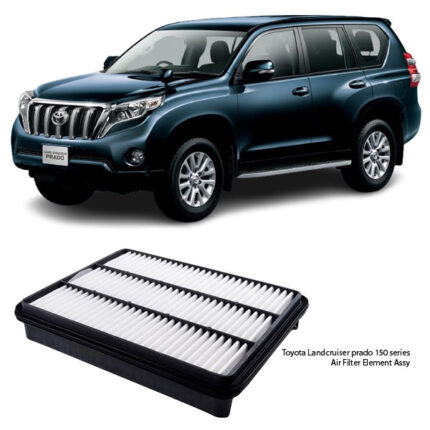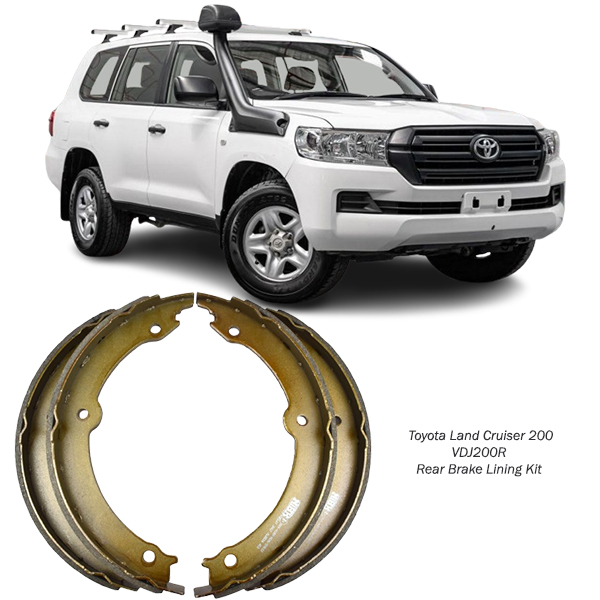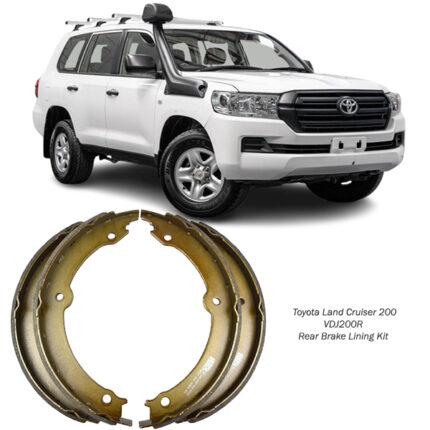Get Toyota Land Cruiser 200 VDJ200R Rear Brake Lining Kit 46530-60020 in Kenya
The Rear Brake Lining Kit is an essential component of a vehicle’s braking system. It is designed to ensure effective stopping power and overall safety while driving. The rear brake lining kit consists of brake linings, also known as brake pads in modern vehicles, that are responsible for applying friction to the brake drum or disc, helping to slow down or stop the vehicle. This guide explores the various aspects of a rear brake lining kit, including its components, functionality, installation, maintenance, and signs of wear.
1. What is a Rear Brake Lining Kit?
The rear brake lining kit refers to the set of components used to apply friction to the rear brakes of a vehicle. It is part of either the drum brake or disc brake system, both of which serve the same purpose but use different mechanisms.
- Drum Brakes: In drum brakes, the brake linings (or brake shoes) press against the inner surface of a rotating drum. The friction slows down the drum, which in turn slows down the vehicle.
- Disc Brakes: In disc brakes, the brake lining (or brake pad) is clamped onto a rotating disc (the rotor). The friction generated between the brake pads and the rotor reduces the speed of the vehicle.
Although modern vehicles predominantly use disc brakes, drum brakes are still common in the rear axle of many cars, especially in economy models and older vehicles.
2. Components of a Rear Brake Lining Kit
A rear brake lining kit typically contains all the parts needed to replace the brake linings, and in some cases, other related components to ensure the rear braking system operates efficiently. The main components of a rear brake lining kit include:
a. Brake Linings (Brake Pads or Shoes)
The primary component of the kit is the brake lining, which consists of a friction material. This material is typically a composite of various materials like steel, rubber, copper, and ceramics, designed to provide the necessary friction without compromising on the longevity of the brake system. Brake linings come in different formulations depending on the application, and the material used impacts braking performance, noise levels, and wear.
- Drum Brake Linings (Shoes): These are curved and made of a metal backing with a friction material attached to it. When the brakes are applied, the shoes expand against the drum, creating friction that slows down the vehicle.
- Disc Brake Pads: These are flat components that press against the brake rotor. The pad material is designed to provide sufficient friction for stopping the vehicle while dissipating heat generated by braking.
b. Retaining Springs and Clips
Retaining springs and clips are used to secure the brake linings or shoes in place. These components ensure that the linings stay firmly positioned in the brake assembly and help prevent vibrations, which could lead to noise or premature wear.
c. Adjusting Mechanism
In drum brake systems, an adjusting mechanism (often a star wheel) is used to ensure that the brake shoes remain at the correct distance from the drum as the brake linings wear down. This helps maintain consistent braking performance over time. Some rear brake lining kits may include these adjusting mechanisms as part of the kit.
d. Hardware Kit (Optional)
Depending on the kit, a rear brake lining kit may include additional hardware components such as lubricants, anti-squeal shims, or replacement pins and bolts. These parts help ensure that the braking system operates smoothly, reduces noise, and extends the lifespan of the components.
3. How Rear Brake Lining Kits Work
The function of a rear brake lining kit depends on whether the vehicle is using a drum or disc brake system:
Drum Brakes:
When the brake pedal is pressed, brake fluid is forced into the wheel cylinders, which push the brake shoes against the inside of the rotating drum. The friction created by the brake linings reduces the rotation of the drum and, consequently, the rotation of the wheels, slowing or stopping the vehicle.
- Friction Material: The brake lining material has a high coefficient of friction to create the necessary stopping power.
- Heat Dissipation: When the brakes are applied, heat is generated due to friction. The brake lining material needs to be able to absorb and dissipate this heat efficiently to prevent overheating and brake fade.
Disc Brakes:
In disc brake systems, when the brake pedal is depressed, hydraulic pressure forces the brake pads to clamp against the brake rotor. The friction between the brake pads and the rotor slows down the rotation of the wheels, thereby slowing the vehicle.
- Rotational Friction: The brake pads need to apply sufficient pressure to the rotors to generate the required friction without causing damage or excessive wear to either component.
- Heat Resistance: Disc brakes can generate a significant amount of heat during braking. High-quality brake lining materials are designed to withstand these high temperatures without losing their effectiveness.
4. Importance of Rear Brake Lining Kits in Vehicle Safety
The rear brake lining kit is integral to vehicle safety as it directly affects the performance and responsiveness of the braking system. Here’s how rear brake linings contribute to the vehicle’s overall safety:
- Effective Stopping Power: Properly functioning rear brake linings ensure that the vehicle can stop quickly and effectively, reducing the risk of accidents.
- Even Brake Force Distribution: In many vehicles, especially those with rear drum brakes, the rear brakes are responsible for a significant portion of the vehicle’s stopping power. Having properly maintained rear brake linings ensures that the braking force is distributed evenly between the front and rear axles.
- Control and Stability: The rear brakes also play a critical role in maintaining vehicle control, particularly when driving at high speeds or during emergency braking. Worn or damaged rear brake linings can lead to reduced braking performance, resulting in longer stopping distances and potential loss of control.
5. Installation of Rear Brake Lining Kits
The installation of a rear brake lining kit is a relatively straightforward process but does require some mechanical knowledge and skill. The process generally involves the following steps:
a. Safety Precautions
Before beginning the installation, it is important to ensure that the vehicle is securely elevated on a jack and supported with jack stands. This prevents accidents during the process.
b. Removal of Old Brake Linings
The first step is to remove the old brake linings. This involves removing the wheel, brake drum (for drum brakes), or rotor (for disc brakes), and unbolting or unfastening any retaining hardware.
c. Inspection of Related Components
Before installing the new brake linings, it is a good idea to inspect related components, such as the brake drums or rotors, wheel cylinders, and hydraulic lines, for any damage or wear.
d. Installation of New Brake Linings
Next, install the new brake linings (brake shoes or pads) by following the manufacturer’s instructions. Be sure to install any necessary retaining hardware, such as springs, clips, or bolts, and check that everything is securely fastened.
e. Brake Adjustment
For drum brake systems, use the adjusting mechanism to ensure the correct distance between the brake shoes and the drum. This is vital for ensuring proper brake engagement. For disc brakes, ensure that the brake pads are properly aligned with the rotor.
f. Reassembly and Testing
Once everything is reassembled, perform a quick test to ensure that the brake system is functioning properly. Check for any abnormal noises, brake performance issues, or leaks. A test drive may be necessary to confirm proper braking function.
6. Signs of Worn Rear Brake Linings
Over time, the rear brake linings will naturally wear down due to friction. Here are some signs that indicate it may be time to replace the rear brake lining kit:
- Squeaking or Grinding Noises: These noises are often a result of worn-out brake linings, which may expose the underlying metal parts.
- Reduced Braking Performance: If the vehicle takes longer to stop or feels less responsive when braking, it could be due to worn brake linings.
- Vibration or Pulling: A noticeable vibration or pulling to one side when applying the brakes could indicate uneven wear of the brake linings.
- Visible Wear: Inspecting the brake linings visually can also reveal whether they are worn down too much. If the friction material is below a certain thickness, it is time for replacement.
7. Maintaining Rear Brake Lining Kits
Proper maintenance of the rear brake lining kit can help extend the lifespan of the brake system and maintain optimal braking performance. Regularly checking the brake pads or shoes for wear and replacing them before they are completely worn out is important for safety.
- Brake Fluid: Ensure that the brake fluid is at the correct level and that it is free from contaminants.
- Inspection: Regularly inspect the brake linings and related components, such as drums or rotors, for wear and damage.
- Brake System Bleeding: In hydraulic braking systems, ensure that the brake lines are free of air bubbles by bleeding the brake system periodically.
Conclusion
The rear brake lining kit is an essential part of a vehicle’s braking system, contributing to safety, control, and braking performance. Whether the vehicle uses drum brakes or disc brakes, the kit includes components that work together to ensure that the vehicle can stop quickly and effectively. Proper maintenance and timely replacement of worn brake linings are crucial for maintaining the integrity of the braking system and preventing accidents. Regular inspection and prompt replacement of the brake lining kit will ensure that the vehicle remains safe and roadworthy for years to come.
Follow us on Facebook for more parts.




